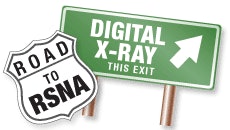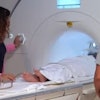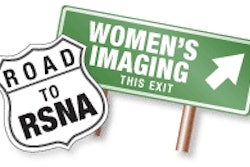This year's presentations on digital x-ray at RSNA 2012 illustrate the rapid advances being made in this modality. Radiography's conversion to digital is making possible the use of advanced image-processing tools once reserved for more advanced modalities, raising the possibility of better patient care at lower radiation doses.
Some of the most exciting presentations to be given at McCormick Place later this month will cover tools such as digital tomosynthesis. Researchers are looking to position the technology in a gatekeeper role between standard radiography and CT for working up suspicious lesions found on chest x-rays.
Digital tomosynthesis will be discussed in a poster presentation on Wednesday at 5:30 p.m. (LL-CHS-WE1D, Lakeside Learning Center), and the basics of tomo for orthopedic applications will be covered in another educational poster (LL-MKE4552). Also, a scientific session will discuss the use of tomosynthesis as a replacement for kidney, ureter, and bladder radiography in patients with suspected urolithiasis (Monday, November 26, 10:40 a.m.-10:50 a.m., SSC14-02, Room S403A).
Computer-aided detection (CAD) is another exciting new technology. Look for a Tuesday session on how CAD improved the yield of tuberculosis screening in Africa (3:00 p.m.-3:10 p.m., SSJ05-01, Room S404CD), as well as a Wednesday talk on how CAD improved the accuracy of images processed with a bone suppression algorithm (10:30 a.m.-10:40 a.m., SSK03-01, Room S404CD).

Meanwhile, radiography utilization comes under the microscope of physician self-referral researchers Dr. David C. Levin and Dr. Vijay Rao of Thomas Jefferson University. They analyzed radiography utilization in the Medicare system, finding that growth in volume peaked in 2005 and since then has fallen -- similar to other modalities. Unlike other modalities, they found little evidence of physician self-referral in x-ray. Be sure to check out this poster on Thursday at 12:15 p.m. in the Lakeside Learning Center (LL-HPS-TH2A).
Don't forget about dose reduction, always an important topic. Duke University researchers will discuss their use of a new technique for estimating radiation dose in a Monday poster presentation (12:15 p.m.-12:45 p.m., LL-PDS-MO2A, Lakeside Learning Center), while also on Monday, Arkansas researchers will demonstrate how DR can lead to lower dose levels for children (12:15 p.m.-12:45 p.m., LL-PDS-MO3A, Lakeside Learning Center).
Also, researchers from Philips Healthcare will show how they were able to reduce dose by using a lower tube voltage in a Monday evening poster (5:30 p.m.-6:00 p.m., LL-PHS-MO1D, Lakeside Learning Center), while a Carestream Health team will present their own solution for lower dose in pediatric neonatal studies on Tuesday (3:15 p.m.-3:25 p.m., VSPD32-02, Room S102AB).
In refresher courses worth noting, be sure to check out a Tuesday afternoon session entitled "Common Problems in Thoracic Imaging" (4:30 p.m.-6:00 p.m., RC401, Room S406B), and a Thursday afternoon minicourse that includes a presentation on implementing and managing a computed radiography quality assurance program (4:30 p.m.-6:00 p.m., RC723, Room E351).
Also be sure not to miss a Thursday afternoon session on digital radiography image processing for technologists (1:00 p.m.-2:00 p.m., MSRT54, Room N230), as well as a poster presentation on "optical illusions" in radiographs that can challenge radiologists (LL-CHE2319, Lakeside Learning Center).
Finally, check out a poster on how and why dual-energy digital subtraction should be used (LL-CHE2366, Lakeside Learning Center).
See below for previews of digital x-ray-related scientific papers and posters at this year's RSNA meeting. To view the RSNA's listing of abstracts for this year's scientific and educational program, click here.



















